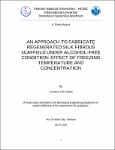| dc.description.abstract | Cell encapsulation, which adding cell into material before the scaffold fabrication, could
overcome the disadvantages of cell culture such as low seeding efficiency and high rate
of cell detachment. However, in previous study, cell encapsulation was not applied for
Regenerated Silk Fibroin (RSF) because the alcohol-immersing step of RSF scaffold
fabrication process was toxic for cells. This study was aimed to develop an alcohol-free
process to fabricate a 3D highly porous scaffold from RSF solution that could be applied
for cell encapsulation. The effect of frozen temperature, frozen time, temperatureincreasing
rate of freeze-thaw process and concentration of silk solution to silk protein
self-assembly, scaffold formation, pore size and pore uniformity were investigated. The
microscopic images showed that pore size of silk scaffold could be controlled by RSF
solution’s concentrations, varied from about 50 μm to 450 μm. The pore interconnection,
and the structural transform were also confirmed. In vivo results showed that silk porous
scaffold supported for cell proliferation, migration and capillary formation.
KEY WORDS: RSF solution, 3D scaffold, alcohol-free fabrication, controlled pore size. | en_US |


